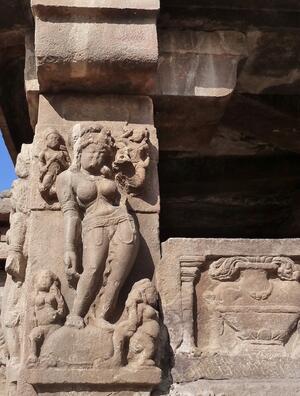Iconoclasm in the Premodern World
Organizers: Carolyn M. Laferrière
To remove, damage, or destroy a monument or image powerfully communicates dissenting ideas about social, political, or religious ideologies, perhaps even more so than the original act of creation or installation. At the heart of these controversies are fundamental disagreements—even historic struggles—over what images mean, what representation can and should do, and how a society should engage with the spaces in which these images are displayed. During the 2020-21 academic year, the Center for the Premodern World will offer a series of four presentations that engage with these themes, moving from works of art and monuments in the Greco-Roman world to China and India. By exploring how the concept of iconoclasm, the urge to destroy or deface images and monuments, functioned in the premodern world, we might also catch a glimpse of why and how monuments continue to be sites of such conflict, violence, and trauma.
Past Events
Capturing Northern River Goddesses for Deccan India
Please register HERE
Speaker: Subhashini Kaligotla, Assistant Professor
Indian and South Asian Art, Department of the History of Art
Yale University
From as early as the seventh century CE, the northern Indian rivers, Ganga and Yamuna, featured in the political discourse of peninsular Indian kings. For the imperial Chalukyas, Rashtrakutas, and Cholas, capturing Ganga and Yamuna signified at once their conquest of north India and their status as transregional powers. This lecture examines the material record—specifically, the sculptural representations of these northern rivers, who were personified as beautiful goddesses at the thresholds of Deccan temples and monasteries. Looking at wider medieval practices involving the looting of images and iconoclasm, I ask how closely Deccan river goddess imagery can be associated with the rhetoric of political violence.
About the speaker: Subhashini Kaligotla’s research focuses on sacred architecture—Buddhist, Hindu, and Jain—with emphasis on the ancient and medieval periods. Her forthcoming book, Shiva’s Waterfront Temples: Architects and their Audiences in Medieval India (Yale University Press, 2022), examines the creative resources of Deccan architects in dialogue with the response of their contemporary audiences. The book is an account of the shared cultural and aesthetic values that shaped built space in the medieval Deccan. A second book project, provisionally titled Seeing Ghosts, is interested in the iconographies of death and the afterlife in early Indian Ocean worlds. Kaligotla is also a practicing poet and author of the poetry collection, Bird of the Indian Subcontinent (2018).

Cancel Culture in Antiquity: Confronting the Monumental Legacy of Rome’s “Bad” Emperors
Wednesday, March 31 at 5pm (PT) via Zoom
Please register HERE
Ancient Rome developed its own form of cancel culture to deal with the monuments of condemned emperors whose memories were subjected to post mortem sanctions. Beginning in the first century CE strong traditions emerged for destroying, defacing, erasing and recycling the representations of overthrown rulers like Caligula, Nero, Domitian, Commodus and others. Mutilated and altered images were transformed on a widespread scale across media into powerful anti-monuments and counter-monuments within the memorial landscape of the ancient city

Toward a Religio-Environmental Ethics through Heritage Conservation in Postsocialist China
Sonya S. Lee (Associate Professor of Art History, East Asian Languages & Cultures, and Religion | Director of East Asian Studies Center)
Thursday, February 4 at 4pm| Please register HERE
In recent years, several high-profile restorations of centuries-old Buddhist monuments in southwest China have raised questions about the value and method of preserving religious icons in a society that reveres tradition but also has a long history of heritage destruction. Focusing on the case of the Laitan Buddha in Hechuan, this lecture brings a sustainability perspective to the debate by discussing how conservation practices and community involvement can contribute to a religio-environmental ethics that encompasses both nature conservancy and cultural preservation.

“Classicism and the Statue Crisis in the age of Black Lives Matter”
Wednesday, October 28 4:00PM (PST)| Register for this virtual event here
Speaker: Professor Verity Platt, Cornell University
We are living in an age of “Fallism”, in which the destruction or removal of statues of discredited historical figures has come to play a vital role in decolonizing and social justice movements. Classics scholars have been keen to draw parallels with iconoclasms of the past, from Roman damnatio memoriae to the Protestant Reformation. But what good do such parallels and genealogies serve at a time when the academy is also facing a reckoning with its own institutional racism? When the foundations of western monumentality are being so profoundly challenged or egregiously appropriated, what might scholars of that tradition contribute to the debate? Drawing on recent events – from the felling of Edward Colston’s statue in Bristol, UK, to Trump’s recent Executive Order for “Monuments to American Heroes” – this lecture explores the ethics and limitations of classical art history at a moment of political and disciplinary crisis.

